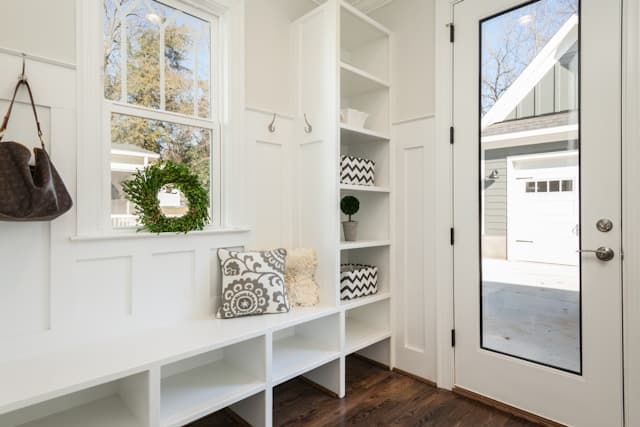How to Design a Multifunctional Mudroom with Space-Saving Features?

Imagine walking into your house after a long day, and instead of being greeted by a cluttered entryway, you see a beautifully organized mudroom. This room is not just a space to kick off your shoes. It’s a multi-purpose area that’s been thoughtfully designed with storage options and space-saving features, creating a functional and aesthetically pleasing entryway. This article will guide you through the process of designing such a mudroom, offering tips and ideas to help you make the most of your space.
Choosing the Right Location for Your Mudroom
The first step in designing your mudroom is choosing the right location. This will depend on your house layout and your specific needs. Your mudroom could be a separate room, a part of your laundry or kitchen, or an area in your garage.
Lire également : What’s the Ideal Setup for a Home Crafting Studio for Jewelry Making?
If you have a side door that leads to your garage, this could be a perfect location. You can add a separating wall or door to create a distinct mudroom area. If you’re short on space, consider transforming a part of your laundry or kitchen into a mudroom. This can be achieved by dedicating a wall for storage and adding a bench with shoe storage underneath.
When choosing the location, consider the traffic flow in your house. Ideally, the mudroom should be near the entrance that you use most often. This will make it convenient to drop off your belongings as soon as you walk in.
En parallèle : What Are the Effective Steps for Creating a Home Disaster Preparedness Kit?
Planning Your Mudroom Storage
One of the main benefits of a mudroom is its storage capability. However, the storage should be designed with a purpose. Think of the items you typically carry in and out of your house. Do you need a place to hang coats and umbrellas? Would you benefit from a dedicated spot for your keys and mail? Do you need storage bins for your children’s backpacks and sports equipment?
Once you’ve assessed your needs, you can plan your storage accordingly. Add wall hooks for coats and hats. Install a storage bench with cubbies underneath for shoes. Add storage bins on higher shelves for seasonal items like gloves and scarves.
Remember that your mudroom storage should not just be functional, but also visually appealing. A white wall with wooden shelves and black coat hooks can be both practical and stylish. You could also add a touch of your personal style with decorative baskets or vintage crates for storage.
Designing the Room Layout
The layout of your mudroom is crucial in creating a space-efficient room. It should allow for easy movement and quick access to stored items. When planning the layout, remember to consider the size of your family and the frequency of use.
The room layout can be enhanced by adding a simple yet functional piece of furniture. For instance, a storage bench not only provides a place to sit and take off shoes but can also increase storage space. Also, a floor mat near the door will keep dirt from spreading into the rest of the house.
In terms of design, it’s possible to keep the mudroom in line with the rest of your home’s style. For instance, if your house has a sleek, modern design, opt for minimalist furniture and fixtures in your mudroom. On the other hand, if your home is more rustic or traditional, choose elements that reflect this style.
Incorporating Additional Features
If your space permits, why not consider adding additional features to your mudroom? This could make it an even more multi-functional space. One popular idea is to combine the mudroom with the laundry room. This allows you to make use of the plumbing already in place for a sink where you can wash dirty hands and shoes.
Another idea is to add a mini office area in your mudroom. A small desk and a wall-mounted organizer could be a great place to sort mail and manage family schedules.
Lighting is also an important feature to consider. A well-lit mudroom is essential for functionality, especially during darker winter months. Consider a combination of overhead lighting and task lighting, such as under-cabinet lights for illuminating specific areas.
Designing a Mudroom that Matches Your Lifestyle
Finally, remember that your mudroom should be designed to cater to your specific lifestyle. It should simplify your life, not complicate it. This means that your design, storage and additional features should all work towards making your daily routines easier.
For instance, if your family enjoys outdoor activities like hiking or skiing, ensure there’s enough space to store bulky equipment. If you have pets, add a pet station with food bowls, a leash hook, and a small closet for pet supplies.
Your mudroom can be more than just a transitional space in your house. With careful planning, it can be a multifunctional room that provides ample storage and contributes to an organized and clutter-free home.
Optimizing Mudroom Functionality with Interior Design
Interior design plays a crucial role in creating a functional yet stylish mudroom. It’s not merely about choosing chic furniture or lighting fixtures; it’s about using design elements to optimize the functionality of your space.
If your mudroom merges with a laundry room, consider installing a washer and dryer stack to save space. For smaller mudrooms, vertical storage solutions are key. Think tall, slim storage units, wall-mounted racks, or overhead shelves. Hooks are more space-efficient than hangers and are easier for kids to use. A built-in bench with storage underneath is another excellent space-saving feature.
When it comes to colors, lighter shades can make your mudroom appear larger and more inviting. But keep in mind, it’s a high-traffic area prone to dirt and stains, so choose a paint finish that’s easy to clean, like semi-gloss or satin.
Remember, your mudroom should be a reflection of your unique style. Whether it’s modern, rustic, or eclectic, ensure your mudroom complements the rest of your house. Personal touches like family photos, a decorative mirror, or a vibrant rug can add warmth and character to the space.
Creating a Mudroom that Matches Your House Hunters Needs
House hunters often look for homes with functional, well-designed spaces. A well-thought-out mudroom can be a strong selling point. It shows prospective buyers that every square inch of the house is used efficiently.
Design your mudroom with potential buyers in mind. For families with young children, mudroom storage for strollers, backpacks, and sports equipment is a plus. A pet station can be a selling point for animal lovers.
Plan your mudroom’s functionality around different lifestyles. For instance, a "drop zone" near the front door for keys, mail, and sunglasses is a handy feature for busy professionals. For gardeners, a sink for washing muddy hands and garden tools can be a functional addition.
Remember, not every family will use a mudroom in the same way. So, aim for a flexible design that can easily be adapted to different needs.
Conclusion
Designing a multifunctional mudroom with space-saving features doesn’t have to be a daunting task. With careful planning and a bit of creativity, you can transform your entryway into a well-organized, stylish, and highly functional space.
Whether you’re combining your mudroom with your laundry room, adding a mini office area, or simply need a place to drop off your things as you walk in the front door, there’s a plethora of design ideas that can suit your lifestyle.
Remember, the aim is to create a room that facilitates your daily routines and makes your life easier. So, keep your household’s habits, preferences, and needs at the forefront of your planning. This approach will ensure that your mudroom becomes an essential part of your home, contributing to an organized and clutter-free living space that you’ll love.
